
There are so many different types of compression legwear in the market like compression socks, compression stockings, compression tights/leggings, compression shorts, and compression sleeves. While you are doing your research on which one you should go for, you might yourself be slightly confused on which one to get. Well, today I’m going to write about compression leg sleeves and hopefully, this can clear some smoke out of your vision to help you make a better decision on choosing the right compression sleeves leg wear for yourself.
Compression Sleeves for Legs
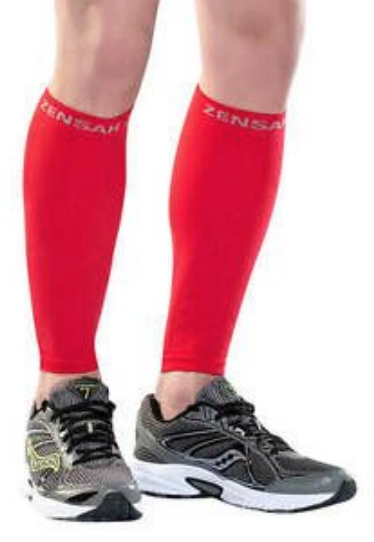
Compression leg sleeves also known as compression calf tights/tube socks. They are invented by the Nelson Knitting Company of Rockford, Illinois, just over 50 years ago, in 1967- the same year that America’s first professional soccer leagues were established. Compression leg sleeves soon became a product of Americans’ simultaneous love of sports, technological innovation, and fashion statements. They are particularly popular for people playing basketball and soccer.
What Do They Do?
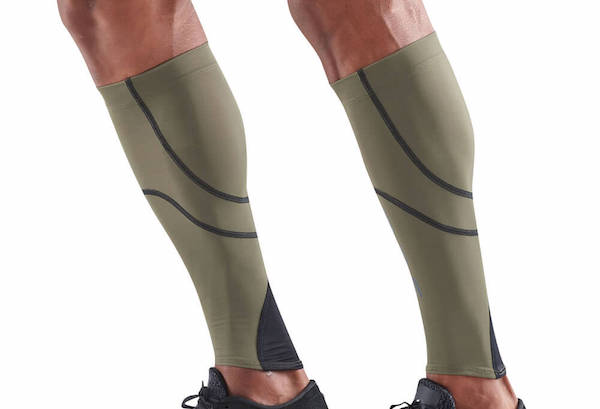
They function under the same principles of compression socks and any other compression legwear in the market. They hug your legs tightly and exert compression pressure on your legs to promote better blood circulation to prevent blood clotting in a certain area of the legs. They also help straighten out the vein walls to a better working state to assist the valves to function properly by opening to allow blood flow toward the heart and closing to prevent blood from flowing backward. The application of the pressure applied on the legs gives the veins that take de-oxygenated blood back to the heart, against gravity, a much-needed boost.
What Happens if Your Blood Circulation is Disrupted?

Do you actually know how important it is to have and maintain a healthy blood circulatory system in your body, especially in the lower limbs? Let me paint you a picture of how your blood circulation works?
Blood circulation is one of the most critical processes in the human body. It is carried out by the body’s most significant organ, the heart, along with a network of blood vessels and other tissues. This process helps carry blood to every nut-and-bolt of your body, allowing even distribution of oxygen and nutrients. It also helps remove waste and fight off potential diseases and illnesses.
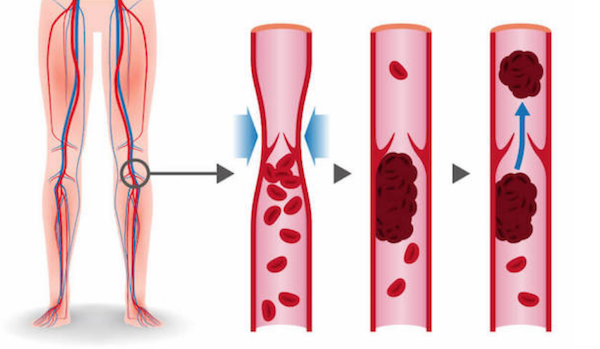
When your blood circulation is screwed up and going zig-zagging around the circulatory system, it can lead to nerve damage, tissue damage, blood clots, etc. Blood clots are formed when the blood circulation at one part of your body is disrupted, on the surface, it could look just like any ordinary bruise. And while there is a blood clotting at a certain part of your body, what it does is making it even harder for the blood to flow back to your heart. It then results in a disruption of the distribution of oxygen and nutrients throughout your body as mentioned above. Poor blood circulation could lead to a list of leg diseases that are serious health concerns and one of the most common ones is Venous Reflux Disease (also known as Chronic Venous Insufficiency).
What is Venous Reflux Diseases?
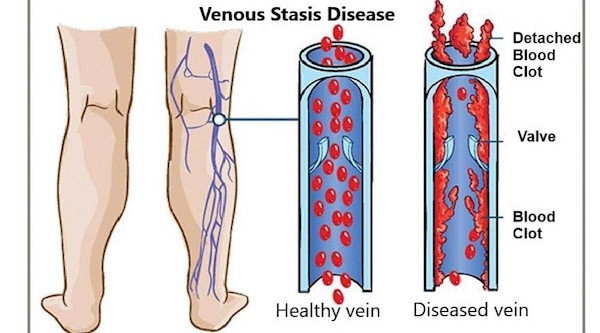
Venous reflux diseases is a medical condition affecting the circulation of blood in the legs. Normally, one-way valves in the veins keep blood flowing toward the heart against the nature of law- gravity. When the valves become weak and could not function properly, they allow blood to flow backward and this is a condition called reflux.
Venous reflux disease can produce a number of clinical problems for the patient and the more serious symptoms like:
- Varicose veins
- Spider veins
- Deep vein thrombosis
- Venous ulcers
- Peripheral edema
- Lymphedema
- Phlebitis
- Lipodermatosclerosis
Now you know how important it is to maintain healthy blood flow, especially in the lower llimbs. Now you are thinking, I train every day, my legs are pretty healthy and are in the best shapes they can be, I should be safe from those horrible leg symptoms. Then, let me ask you a question.
Do you stand or sit for a long period of time every day?

Your answer has to be yes. Because that is basically everyone in the world nowadays. You tell me, whose jobs these days don’t require them to either be on their feet or sit through the whole duty the whole day? STANDING and SITTING are the number one reasons that cause blood flow disruption due to lack of movement in the lower limbs. This is why you need the external compression support provided by wearing compression legwear like compression leg sleeves are great preventive measures to combat all of those above.
What is the Difference Between These Two?
Compression Socks vs Compression Leg Sleeves
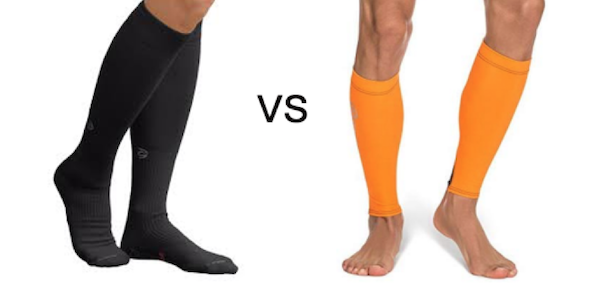
The main difference between compression socks and compression sleeves is that compression socks provide full coverage and compression pressure from your leg to your foot while compression leg sleeves are only worn around the calf and end just above the ankle. Sometimes they provide support to your knees to depends on the length you go for. There are compression leg sleeves that are just below the knee and some that go over the thigh.
Compression leg sleeves are mainly used for intensive training while the compression socks are used for after training. It is not advisable to wear tubes after a workout because there is no compression pressure applied on the foot, only the calf muscle and because of this your foot will be painful and fluid retention can develop.
Meanwhile, compression socks relieve muscle fatigue and stimulate blood lactate removal that enhances recovery. They improve the drainage of blood and flue which fastens the healing process of injuries such as shin, splints, calf, and Achilles tendon problems.
Popular Articles on ComproGear
Rose Toy Rose Bud Vibrator
Compression Stockings mmHg Chart Grades of Compression Stockings
Plus Size Compression Socks XXXL Compression Socks
Graduated Compression Leggings Compression Pants vs Leggings
Best Compression Socks for Standing All Day Socks for Standing Long Hours
Who Should Wear These Sleeves?
Compression Leg Sleeves
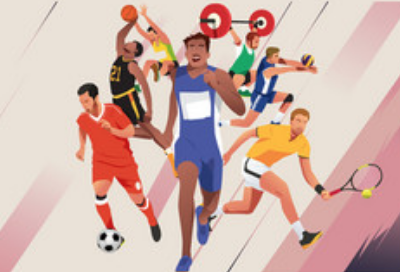
Compression leg sleeves are especially popular among professional or amateur athletes and sports enthusiasts. They are medically proven to be extremely helpful to enhance performances for athletes and sports enthusiasts like:
- Participants of Decathlon
- Participants of Triathlon
- Basketball players
- Soccer players
- Cyclists
- Runners/Marathon runners
- Wrestlers
- Dancers

Helpful benefits and advantages include:
- Improved circulation and blood flow which means more oxygen/nutrients are delivered to the muscles
- Reduces delayed onset muscles soreness that can happen 24 to 72 hours after exercise
- Flushes the body of waste products including carbon dioxide and lactic acid
- Reduces recovery time from injuries, strains
- Can control body temperature
- Improves perceived exertion
- Provides physiological advantages- These can be simply feeling like you look better, which can boost your confidence and motivation
- Aids in proprioception or how you sense your body’s position in space creating a more efficient muscle movement aspect
- Moisture can be repelled or “wicked” away from the body, allowing it to evaporate faster
Best to Wear During Training to Reduce Swelling and Muscle Soreness
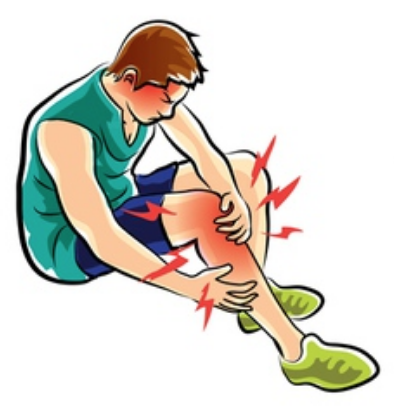
In general, wearing compression leg sleeves helps to reduce swelling on your joints and calf muscles. Runners and triathletes, especially, should wear compression leg sleeves during training because they can help the skeletal-muscle pump, increase deep venous velocity and decrease blood pooling in the calf veins and alleviate delayed-onset muscle soreness. They will help to hold both your muscles and tendons in place when you are rocking on the fields or the gyms. Also, wearing compression sleeves for legs helps to stop the muscles from producing creatine kinase, which causes muscle tissue damage. Additionally, they prevent the formation of lactic acid and improves the tendency of the muscles to recover quickly after each workout.
Best to Wear During Training to Provide Protection From External Elements
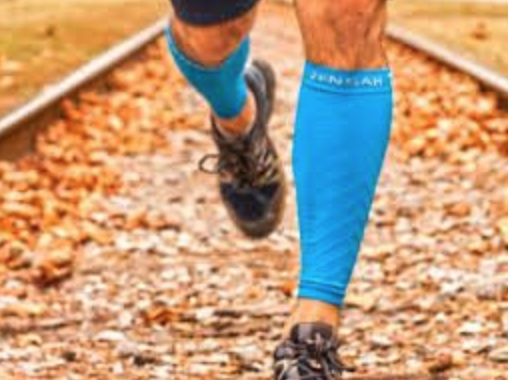
Other than that, they are also a great external tool for your leg as protection against many outdoor elements, scratches, and abrasions, especially for outdoor runners. Trail runners benefit from wearing compression leg sleeves since they are prone to injuries from elements along their trail. Also, when poison ivy comes in contact with your skin, it can cause very painful rashes and compression leg sleeves are here to save the day by acting as a great preventive measure against all those elements.
Other Alternative: Over-the-Knee
Compression Leg Sleeves
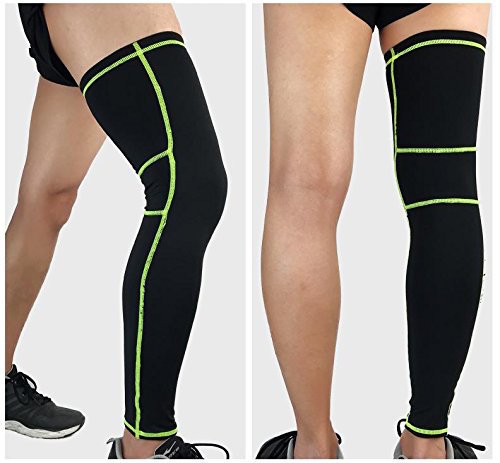
As mentioned above, compression leg sleeves could come in two different lengths: knee-high and over-the-knee. So, what exactly is the difference between the two? There is not much difference except for the extra knee support provided over-the-knee compression leg sleeves.
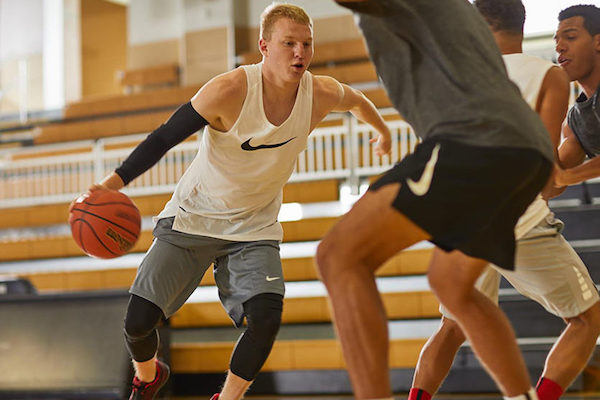
Athletes, especially runners or football players that play sports involving intensive lower leg movement should wear compression leg sleeves that are over the knee to avoid potential knee injuries. Of all the aches and pains that can plague runners, knee pain is one of the most common. According to research, approximately 25 percent of running-related injuries are attributed to patellofemoral pain syndrome (PFPS), or in layman terms- “runner’s knee”.
The most common knee injuries include:
- Fractures
- Tendon tears
- Tendonitis
- Collateral ligament injuries
- Dislocation
The most common knee conditions include:
- Runner’s knee (PFPS)
- IT (iliotibial) band syndrome
- Ligament tears (ACL and MCL tears being the most common)
- Meniscus Tears (a tear of the cartilage in the knee joint)
More Information about Knee Injury

Runner’s knee can often lead to chondromalacia, a condition that develops when the cartilage under the kneecap becomes rough with repeated wear and tear. This “roughening” causes increased friction below the joint’s surface, leading to irritation, inflammation, and pain.
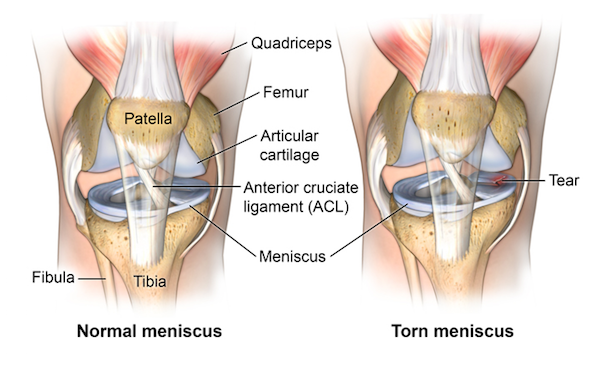
Structural problems such as ligament or meniscus tears are usually another story. These injuries, by definition, suggest damage to one of the stabilizing structures in the knee joint. Symptoms of instability, swelling, limited range of motion, and higher levels of pain are more common with these injuries and are all signs of one should have their knee examined by a doctor before returning to running or playing running-intensive sports.
Wearing These Sleeves Can Prevent Knee Injury

Matter of fact, in 2010, over 10 million visits to the doctor occurred due to knee pain and injury. I’m not going to go deep in the medical terms for all sorts of knee conditions but what I’m trying to say is, these knee injuries are very likely to happen to athletes/sports enthusiasts that play running-intensive sports. Some of the knee injuries are so intense it may very well end your athletic career.
This is why compression leg sleeves are trending and popular among all athletes and sports enthusiasts. I am not saying wearing them will bring the risk of any leg-related injury to zero but wearing them will definitely reduce the risk down to minimal. So, even if you are just an amateur athlete or if you sometimes play a pick-up basketball game during your free time, I highly suggest you go get yourself a pair of compression leg sleeves to enhance your performance during the recreational activities you are into. Not only that but to minimize the chance of getting your legs injured.
Also, remember to switch to a pair of compression socks to enhance recovery after your intense training because compression leg sleeves are more suitable to wear during training and compression socks are used after training as mentioned above. So, remember to take note!
Compression Therapy Guide
Before we say goodbye, let me enlighten you on the complete compression therapy guide to make sure you don’t go ahead and pick the compression level that is too low or too high for you. It could lead to a lower limb blood flow disaster if the compression pressure is too high for you. On the other hand, you won’t get the treatment you need if the compression pressure is too low for you, so you would be essentially wearing them for nothing.
Compression legwear comes in varying degrees of compression pressure levels. Typically, they come in 4 standard compression levels and are measured in millimeters of mercury (mmHg). They are indicated with a range of numbers like “20-30” mmHg, which means that the amount of pressure applied to your legs will not fall below 20 mmHg and not exceed 30 mmHg.

15-20 mmHg Over the Counter
- For the prevention and relief of minor to moderate varicose and spider veins
- Helps relieve tired, aching legs, and minor swelling of feet, ankles, and legs
- Helps prevent varicose veins and spider veins during pregnancy
- Helps prevent Deep Vein Thrombosis, also known as Economy Class Syndrome
- Used in post-sclerotherapy treatment to help prevent the reappearance of varicose veins and spider veins
- Ideal compression level used for those traveling long distances
This low compression level is suitable for everyday wear for everyone out there to help with mild swelling and fatigued legs due to long periods of standing, sitting, and traveling. It is a popular choice for office workers, waiters/waitresses, teachers, chefs, frequent travelers, etc.

20-30 mmHg- Medical Grade Class I
- Helps prevent and relieve moderate to severe varicose veins (also during pregnancy)
- For post-surgical and post sclerotherapy treatment to help prevent the reappearance of varicose and spider veins
- Helps in the treatment of moderate to severe edema or lymphatic edema
- Helps with the management of active ulcers and manifestations of Post-Thrombotic Syndromes
- Helps relieve superficial thrombophlebitis
- Helps prevent Orthostatic Hypotension (or Postural Hypotension)
- Helps prevent Deep Vein Thrombosis, also known as Economy Class Syndrome
The 20-30 mmHg level of compression level is the most widely used medical-grade because it provides competent compression to your legs without being too strong. This level is suitable for varicose veins patients, patients that are recovering from venous surgery and also pregnant women during the third trimester.

30-40 mmHg- Medical Grade Class II
- Helps prevent and relieve severe varicose veins
- Used in the treatment of severe edema and lymphedema
- Used in post-surgical and post-sclerotherapy treatment to help prevent the reappearance of varicose and spider veins
- Helps reduce the symptoms of Orthostatic Hypotension (or Post-Thrombotic Syndrome)
- For the management of Venous Ulcers and manifestations of Post-Thrombotic Syndrome)
- Prevent Deep Vein Thrombosis, also known as Economy Class Syndrome
The 30-40 mmHg level of compression pressure is stronger and is recommended for moderate to severe leg health symptoms. It is great for patients with lymphedema, severe varicose veins, venous reflux disease, and deep vein thrombosis.

40-50 mmHg- Medical Grade Class III
- Acute leg/Ankle swelling
- Varicose veins
- Chronic vein insufficiency
- Deep Vein Thrombosis
The 40-50 mmHg level of compression pressure provides the strongest medical pressure level and it is not for ordinary use. It is best to consult a doctor before considering this level of compression. It is generally indicated for severe venous stasis, wound management, lymphedema.
The End
Get yourself a pair of these magical sleeves
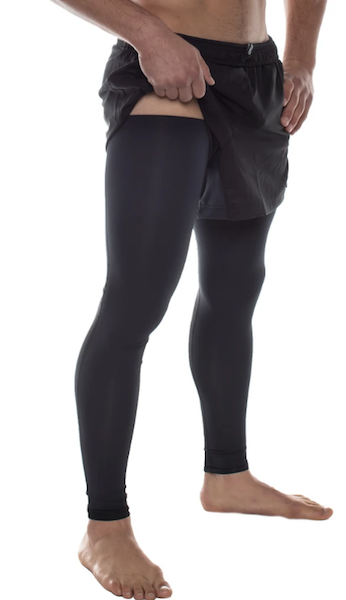
At last, I have 4 “Always” advice to give you before you make your purchase.
- Always make sure you know what compression pressure support you are getting as they come in varying degrees of compression pressure level.
- Always choose the right size so they can fit your calf nicely without being too tight as it can be uncomfortable as they can come in sizes from XS to XL or even a wider range of sizes.
- Always read the product description and read about the materials used in producing the particular ones you are trying to make a purchase to avoid potential allergic reactions.
- Always compare different purchase channels if you decide to purchase online and always go for the more reputable sites.

We are already at the end of the article. I hope this article shined some lights on compression leg sleeves if you were looking for one. Even if you were not, you could be moved by the benefits of wearing these leg sleeves. So, what are you waiting for? Go get one!😉
This page last updated November 2, 2022
